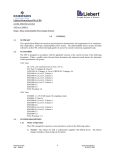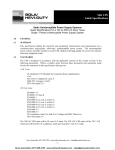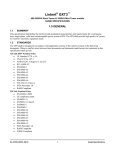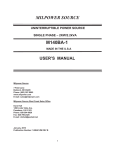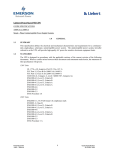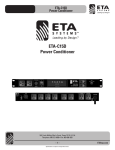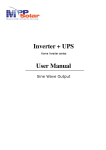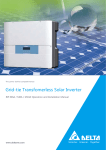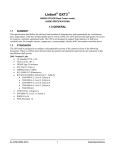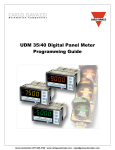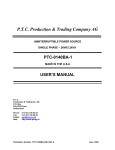Download Sola/Hevi-Duty S3K Series Mini
Transcript
Sola/Hevi-Duty S3K Series Mini-Tower UPS GUIDE SPECIFICATIONS 700VA to 1600VA – 120V models Single - Phase Uninterruptible Power Supply Systems 1.0 1.1 GENERAL SUMMARY This specification defines the electrical and mechanical characteristics and requirements for a continuousduty single-phase, solid-state, uninterruptible power system. The uninterruptible power system, hereafter referred to as the UPS, will provide high-quality AC power for sensitive electronic equipment loads. 1.2 STANDARDS The UPS is designed in accordance with the applicable sections of the current revision of the following documents. Where a conflict arises between these documents and statements made herein, the statements in this specification will govern. 120V Units UL 1778, c-UL listed (to CSA 22.2 No. 107.1) FCC Part 15, Subpart B, Class B ANSI C62.41, Category A, Level 3 (IEEE 587, Category A); EN61000-4-5, Level 3, Criteria B EN61000-4-2, Level 3, Criteria B EN61000-4-3, Level 3, Criteria A EN61000-4-4, Level 4, Criteria A EN61000-4-6 EN61000-3-2 EN61000-3-3 1.3. SYSTEM DESCRIPTION 1.3.1 Modes of Operation The UPS is designed to operate as a line-interactive system in the following modes: A. Normal - The critical AC load is continuously supplied with filtered power. The battery charger maintains a float-charge on the battery. B. Voltage Boost/Buck - During input power source abnormalities (sags and swells), the AC output power is corrected by means of boost (sag correction) or buck (swell correction) compensation taps. Operation of the compensation taps automatically maintains the proper output voltage for the connected critical equipment. The compensation taps is designed for indefinite operation to their limits. Operation of the compensation taps will not discharge the battery. C. Recharge - Upon restoration of utility / mains AC power, after a utility / mains AC power outage and complete or partial battery discharge, the unit automatically restarts and resumes supplying power to the critical AC load; and the battery charger recharges the battery. D. Battery - When the input power source exceeds the parameters defined in section 1.3.3.1, the critical AC load is supplied power by the inverter, which obtains its power from the battery. Typical detection and transfer time is 4-6 ms. E. Battery Start- The UPS is capable of starting without input power. The unit starts up and operates from the battery, with output frequency the same as the last operating frequency. 1.3.2 Design Requirements A. Voltage: Input/output voltage specifications of the UPS are: Gross Automation (877) 268-3700 · www.solahevidutysales.com · [email protected] 1 Gross Automation (877) 268-3700 · www.solahevidutysales.com · [email protected] Input: 0-165 VAC, 60/50 Hz auto-sensing, single-phase, 2-wire-plus-ground. Output:120VAC ±10%, 60/50 Hz, single-phase, 2-wire-plus-ground. B. Output Load Capacity: Maximum specified output load capacity of the UPS, regardless of load power factor, is: 700VA / 480W 1000VA / 750W 1600VA / 1200W C. Internal Battery: The battery consists of valve regulated, non-spillable, maintenance-free, sealed, lead-acid cells. The battery is user replaceable and hot swappable. D. Battery Reserve Time (typical at full load) with ambient temperature 77°F (25°C): 700VA: 5 Min. 1000VA: 3 Min. 1600VA: 3 Min. E. Battery Recharge: The UPS contains a battery recharge rate designed to prolong battery life. Recharge time is 4 hours typical to 90% capacity after a complete discharge into full resistive load. 1.3.3 Performance Requirements 1.3.3.1 AC Input to UPS A. Voltage Configuration: The UPS operates at these values without drawing power from the batteries. 120 VAC nominal: single phase, 2-wire-plus-ground: 85 ─ 145 VAC (±3VAC), Buck compensation: 133VAC (±3VAC) Boost1 compensation: 107VAC (±3VAC) Boost2 compensation: 95VAC (±3VAC) B. Frequency: The UPS automatically senses the input frequency and operates within the following frequency specifications without drawing power from the batteries. 50 or 60 Hz Auto Sensing (±0.5%) C. Surge Protection: The 120 VAC units can withstand input surges of up to 320J without damage per criteria listed in IEEE C62.41, Category A, Level 3. D. Input Connections: The 120 VAC units have an attached input cord 6 feet (1.8 meters) in length, measured between the inside edges of the connectors. The attached input cord has a NEMA 5-15 plug. 1.3.3.2 AC Output A. Voltage Configuration: 120 VAC, 60/50 Hz, single-phase, 2-wire-plus-ground. (Normal mode) 120 VAC, ±5% RMS prior to low battery warning; ±8% RMS after low battery warning (Battery mode) B. Voltage Regulation: ±10% steady state. C. Frequency Regulation: +/-0.5% synchronized to utility / mains. D. Load Power Factor Range: 0.6 lagging to 1.0 (unity). E. Inverter Overload Capability: Overload Warning (visual and audible alarms) occurs between 100%─109% of rated capacity, continuous duty. Shutdown occurs at the following levels: Gross Automation (877) 268-3700 · www.solahevidutysales.com · [email protected] 2 Gross Automation (877) 268-3700 · www.solahevidutysales.com · [email protected] >110 ─ 165%; after 90 seconds (Normal mode) >165 ─ 200%; after 60 seconds (Normal mode) >200% - short-circuit; after 15 cycles (Normal mode) >100 – 110%; after end of discharge (Battery mode) >110%; after 30 seconds (Battery mode) >120%; after 5 cycles (Battery mode) >150%; after 1cycle (Battery mode) F. Voltage Transient Response: ±15% in Normal mode for 0-100-0% loading of the UPS rating, ±5% in Battery mode for 20-100-20% loading of the UPS rating. G. Transient Recovery Time: To within ±8% of nominal voltage in < 2 cycles. H. Efficiency: >95% (Normal mode) >90% (Buck/Boost mode) >70% (Battery mode) 1.4 ENVIRONMENTAL CONDITIONS A. Ambient Temperature Operating: 32oF ─ 104oF (0oC ─ 40oC) for altitudes 0 ─ 5,000 ft. (0 ─ 1500 meters) above sea level 32°F ─ 95°F (0°C ─ 35°C) for altitudes 5000 ft ─ 10,000 ft (1500 ─ 3000 meters) above sea level. 77o F (25oC) for optimum battery performance Storage: 5°F ─ 104°F (-15°C ─ 40°C) with batteries 5oF ─ 122oF (-15oC ─ 50oC) without batteries 68oF (20oC) for optimum battery storage. B. Relative Humidity 0 ─ 95% non-condensing. C. Altitude: 3,000 m (10,000 ft. max.), without power derating when operated within the temperature specified in section 1.4.A. D. Audible Noise Noise generated by the UPS during normal operation does not exceed 50 dBA. E. Electrostatic Discharge The 120 VAC units are able to withstand an electrostatic discharge compliant to EN61000-4-2, level 3, Criteria B without damage and without affecting the connected load. The 230 VAC units are able to withstand an electrostatic discharge compliant to EN61000-4-2, level 3, Criteria B without damage and without affecting the connected load. 1.5 USER ACCESSORIES AND PACKAGING The specified UPS system is supplied with one (1) user's manual. The manual includes installation drawings and instructions, a functional description of the equipment, safety precautions, illustrations, operating procedures, and general maintenance guidelines. The UPS is also supplied with one (1) UPS Gross Automation (877) 268-3700 · www.solahevidutysales.com · [email protected] 3 Gross Automation (877) 268-3700 · www.solahevidutysales.com · [email protected] Monitoring Software CD (UPSMON bundle version), one (1) RS232 Communications Interface Cable with DB9 Connectors at both ends (6 feet, 1.8m) and one (1) RJ-11 cord (6 feet, 1.8m). 1.6 WARRANTY The manufacturer warrants the UPS against defects in materials and workmanship for one (1) year. 1.7 QUALITY ASSURANCE 1.7.1 Manufacturer Qualifications Sola/Hevi-Duty provides more than twenty years experience in the design, manufacture, and testing of solid-state UPS systems and the company is certified to ISO 9001. 1.7.2 Factory Testing Before shipment, the product is tested to assure compliance with the specification. 2.0 2.1 PRODUCT FABRICATION All materials and components making up the UPS are new, of current manufacture, and have not been in prior service except as required during factory testing. All relays are provided with dust covers. 2.1.1 Wiring Wiring practices, materials, and coding are in accordance with the requirements of the standards listed in section 1.2. All wiring is copper. 2.1.2 Cabinet The UPS unit comprised of: TVSS & EMI/RFI Filters, Relay, Automatic Voltage Regulator, Battery Charger, Battery consisting of the appropriate number of sealed battery cells and Inverter is housed in a mini-tower NEMA type 1 enclosure. The UPS cabinet is injection-molded standard color. Dimensions and weights are: UNIT 2.1.3 UNIT DIMENSIONS WEIGHT W x D x H in (mm) lbs (kg) 700VA 5.5 x 17.2 x 8.3 (140 x 436 x 210) 31.9 (14.5) 1000VA 5.5 x 17.2 x 8.3 (140 x 436 x 210) 34.8 (15.8) 1600VA 8.9 x 17.7 x 6.7 (226 x 450 x 170) 66 (30) Cooling The UPS is forced air cooled by variable speed internal fan(s), which operate only when needed to maintain internal temperatures to acceptable levels. Air intake is through the front of the unit and exhausted out the rear of the unit. 2.2 COMPONENTS AND OPERATION 2.2.1 Input Protection The UPS has built-in protection against undervoltage, overcurrent, and overvoltage conditions including low-energy lightning surges introduced on the primary input power source. The UPS is provided with an input circuit protector. The UPS will withstand input surges without damage per criteria listed in IEEE C62.41, Category A, Level 3. Additionally, the UPS is supplied with one Gross Automation (877) 268-3700 · www.solahevidutysales.com · [email protected] 4 Gross Automation (877) 268-3700 · www.solahevidutysales.com · [email protected] pair of Data Line Protection Connectors to provide phone, fax or modem line surge protection via RJ-45 connectors. These Data Line Protection Connectors provide transmission for 10/100 BaseT Ethernet connections. 2.2.2 Battery Recharge The UPS contains a battery recharge rate designed to prolong battery life. The battery is constant voltage charged to recharge and maintain the battery in a fully charged state. Recharge time is 4 hours maximum to 90% rated capacity after discharge into full resistive load. 2.2.3 Output Protection For output faults including short circuits and overloads, the UPS is protected by the input circuit protector during Normal mode and by electronic current limiting during Battery mode. 2.2.4 Overload The UPS is capable of supplying power for overloads exceeding 100% and up to 110% of full load rating, continuously. A visual indicator and audible alarm indicate overload operation. For greater current demands, the UPS employs circuit protector and electronic current-limiting protection to prevent damage to components. The UPS is self-protecting against any magnitude of connected output overload. The UPS control logic senses and disconnects the UPS from the critical AC load and clears the protective device during Normal mode. 2.2.5 Output Frequency An oscillator controls the output frequency of the UPS. The oscillator maintains the output frequency to + 0.5 Hz of nominal when not synchronized to the utility/mains source. 2.2.6 Battery Over-Discharge Protection To prevent battery damage due to excessive discharge levels, the UPS control logic automatically monitors the battery voltage and load level and switches off the output at the predetermined battery shutdown voltage set point. 2.2.7 Display and Controls 2.2.7.1 General The UPS is provided with a microprocessor-based unit status and control display designed for convenient and reliable user operation. The status and alarm indicators are displayed on a status indicator display. 2.2.7.2 System Indicators There is a row of Load Level indicators that display the approximate electrical load placed upon the UPS. There is also a row of Battery Level indicators that display the approximate battery capacity. Finally, there are seven (7) status indicators on the UPS as described below: The “Line Normal” indicator (GREEN LED, front panel) illuminates when utility power is normal. The “Site Wiring Fault” indicator (RED LED, rear panel) illuminates when the UPS detects a Site Wiring Fault. The “Back Up” indicator (GREEN LED, front panel) illuminates when the UPS is operating on battery and the UPS will produce slow beeping sound. The “Replace Battery” indicator (RED LED, front panel) illuminates when the internal battery is discharged and must be replaced. PLEASE NOTE THAT ONCE THE BATTERY HAS DISCHARGED TO UNDER 25% OF RATED CAPACITY, THE UPS WILL PRODUCE A RAPID BEEPING SOUND. Gross Automation (877) 268-3700 · www.solahevidutysales.com · [email protected] 5 Gross Automation (877) 268-3700 · www.solahevidutysales.com · [email protected] The “Overload” indicator (RED LED, front panel) illuminates when the loads connected to the UPS exceed the UPS’s rated capacity. At the same time, the UPS will produce a continuous beeping sound as long as the unit is overloaded. The “Buck AVR” indicator (YELLOW LED, front panel) illuminates when the UPS is correcting a high utility voltage condition and providing normal voltage to the connected loads. The “Boost AVR” indicator (YELLOW LED, front panel) illuminates when the UPS is correcting a low utility voltage condition and providing normal voltage to the connected loads. 2.2.7.3 ON/TEST & OFF Buttons ON - When the UPS is Off, pressing the ON/Test button for more than one (1) second will start the UPS. The UPS is capable of starting on battery (battery start). The “ON/TEST” button also activates the self-test function. OFF Button - When the UPS is on (in either Normal or Battery mode), pressing the OFF button for more than one (1) second will shut down the UPS. 2.2.8 Internal Battery Valve regulated, non-spillable, lead-acid cells are used as a stored-energy source for the specified UPS system. The battery is housed internal to the UPS cabinet, and sized to support the inverter at rated load and power factor, with ambient temperature of 77 o F (25 o C) for a minimum of 3 minutes reserve time. The expected life of the battery is 3 - 5 years or 250 complete discharge cycles. 2.2.9 Data Line Protection Connectors Data line (in and out) connectors are on the rear of the UPS and provide transient voltage surge suppression (TVSS) for Phone/Fax/DSL/Internet/Modem devices. 2.2.10 Output Distribution Output distribution is integral to the UPS and is located on the rear of the unit. UNIT 2.2.11 OUTLETS 700VA & 1000VA (4) NEMA 5-15R 1600VA (6) NEMA 5-15R Communications The UPS has a DB-9 (9 pin female) connector on the rear to allow UPS status communications with a computer system running UPSMON software. The DB-9 is capable of supplying serial communication, on battery and low battery signals. The pin out configuration of the DB9 connector is: Pin 1 2 Assignment Description Not used Power Failure, Hi to Lo signal produced Gross Automation (877) 268-3700 · www.solahevidutysales.com · [email protected] 6 Gross Automation (877) 268-3700 · www.solahevidutysales.com · [email protected] 3 4 5 6 7 8 9 Not used Reference ground for Pins 2 and 5 Low battery, Hi to Lo signal produced RS-232 data output (R X D) * Reference ground for Pin 6 Not used RS-232 data output NOTE: Pins 2 and 5 are open collector outputs that must be pulled up to a common reference supply no greater than +40VDC, 25mA, non-inductive. Use only Pin 7 as the common. * The UPS will shut down when a high RS-232 level is sustained on Pin 6 for 0.36 seconds. 2.2.11.1 Any Mode Shutdown - Via Pins 5 & 6 When Pin 6 is shorted to Pin 5, the UPS output is shut Off regardless of what mode the UPS is operating in. The UPS cannot be started as long as the pins are shorted. When the short is removed, the UPS output can be enabled by pressing the ON/TEST button. 2.2.11.2 Battery Mode Shutdown—Via Pins 5 & 2 While the UPS is operating on battery (with no battery test in progress), a 5-12VDC signal for 2 seconds or longer is required to signal a shutdown. Signals for less than 2 seconds are ignored Gross Automation (877) 268-3700 · www.solahevidutysales.com · [email protected] 7 Gross Automation (877) 268-3700 · www.solahevidutysales.com · [email protected]







